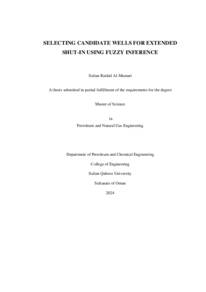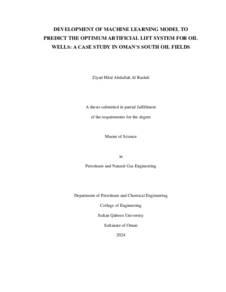Document
Selecting candidate wells for extended shut-in using fuzzy inference.
Source
Master's thesis
Other titles
إختيار الآبار المرشحة للإغلاق الطويل عن طريق الاستدلال الضبابي
Country
Oman
City
Muscat
Publisher
Sultan Qaboos University
Gregorian
2024
Language
English
Thesis Type
Master's thesis
English abstract
Decision-making has always been a challenging matter, and this holds true in the oil
and gas industry. Selecting candidate wells for shut-in is one example, which becomes
even more challenging when it is for an extended period. Long-term shut-ins can be
caused by uncontrollable factors such as environmental reasons or safety
considerations. The oil industry also turned to shut-ins as a method to mitigate the
impact of economic downturns. The petroleum industry recently experienced this
problem due to the COVID-19 pandemic, which led to around a year of extremely low
prices. Many small and large companies resorted to shutting their wells for extended
periods to cope with the economic downturn. The issue with such practices is that
there is no concrete standard to select the most optimal candidates. The decisionmaking process usually involves analysis-based techniques that can be timeconsuming.
This study aims to utilize fuzzy logic in assisting with the real-time decision-making
challenge of selecting candidate wells for extended shut-ins. Fuzzy logic
implementation in the petroleum industry has been widely embraced, improving
processes in different areas like reservoir characterization, drilling operations, and
decision-making problems. That is done thanks to fuzzy logic’s ability to resemble
human-like thinking and account for the uncertainties and vagueness inherent in the
subsurface systems. A fuzzy expert system was built using Python to select the best
candidates for shut-in based on the net present value (NPV). The system was designed
using simulation data of a mature field producing from a sandstone reservoir. The
workflow of the system can be summarized in three parts. The first clusters the wells
into three distinct groups based on performance, then the second part recommends the
shut-in scenario for the clusters based on the economic conditions. The last component
makes the final shut-in decision based on the results of the two previous parts.
Exploratory data analysis techniques and earlier studies were used as guidelines to
build the system. An economic analysis of a 3-year forecast was conducted for several
scenarios to validate the results of the system. This study demonstrates the efficiency
and convenience of fuzzy inference systems when used in real-time decision-making
problems. However, adjustments are needed when applying it to different fields and
reservoirs, as the production behavior can differ greatly.
Arabic abstract
اتخاذ القرارات دائما ما كانت مسألة صعبة، وهذا ينطبق على صناعة النفط والغاز. اختيار الآبار المرشحة للإغلاق هو مثال واحد، والذي يصبح أكثر تحديًا عندما يكون لفترة طويلة. يمكن أن تكون الإغلاقات طويلة الامد ناتجة عن عوامل لا يمكن السيطرة عليها مثل الاسباب البيئية أو الاعتبارات الامنية. كما توجهت الصناعة إلى الإغلاقات كوسيلة للتخفيف من تأثير الركود الاقتصادي. عانت صناعة البترول مؤخ ًرامن هذه المشكلة بسبب جائحة كوفيد،19- التي أدت إلى حوالي عام من الاسعار المنخفضة للغاية. لجأت العديد من الشركات الصغيرة والكبيرة إلى إغالق آبارها لفترات ممتدة للتعامل مع الظروف الاقتصادية. المشكلة في مثل هذه الممارسة هي عدم وجود معيار ملموس و محدد لإختيار الآبار مثالية. عادة ما يشمل عملية اتخاذ القرار تقنيات تستند إلى التحليل والتي يمكن أن تكون مستهلكة للوقت. تهدف هذه الدراسة إلى استخدام المنطق الضبابي (Logic Fuzzy (في المساعدة في تحدي اتخاذ القرارات في الوقت الفعلي الختيار الآبار المرشحة للإغلاق لفترات طويلة. تم تبني تنفيذ المنطق الضبابي في صناعة البترول على نطاق واسع، مما أدى إلى تحسين العمليات في مجالات مختلفة مثل توصيف المكامن Reservoir( (Characterization، وعمليات الحفر، ومشكالت اتخاذ القرار. يتم ذلك بفضل قدرة المنطق الضبابي على محاكات التفكير البشري التعامل مع الغموض عدم الدقة في الانظمة الجوفية. تم بناء نظام ضبابي باستخدام Pythonالختيار أفضل المرشحين للإغلاق بنا ًء على القيمة الحالية الصافية (NPV (. تم تصميم النموذج باستخدام بيانات المحاكاة لحقل قديم ينتج من مكمن رملي. يمكن تلخيص سير عمل النظام في ثلاثة أجزاء. الاول يقوم بتجميع الآبار في ثالث مجموعات مختلفة بنا ًء على الاداء، ثم الجزء الثاني يوصي بسيناريو الاغالق للمجموعات بنا ًء على الظروف الاقتصادية. الجزء الاخير يتخذ قرار الاغالق النهائي بنا ًء على نتائج الجزئين السابقين. تم استخدام تقنيات تحليل البيانات الاستكشافية (EDA(، جنبًا إلى جنب مع الدراسات السابقة، للمساعدة في بناء النظام. تم إجراء تحليل اقتصادي لتوقعات لمدة 3 سنوات لعدة سيناريوهات للتحقق من صحة نتائج النظام. توضح هذه الدراسة كفاءة وفعالية أنظمة الاستدالل الضبابي عند استخدامها في مشكلات اتخاذ القرارات في الوقت الفعلي. ومع ذلك، تتطلب التعديالت عند تطبيقها على أنظمة نفطية مختلفة، حيث يمكن أن يختلف سلوك الانتاج بشكل كبير.
Category
Theses and Dissertations


